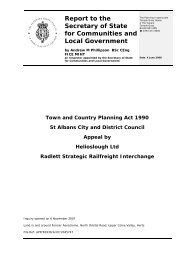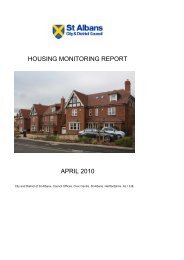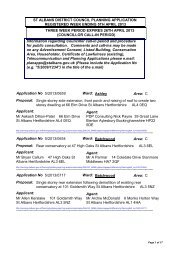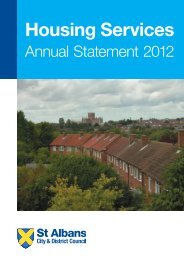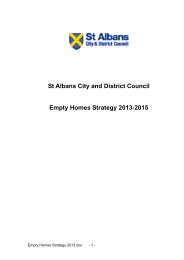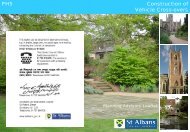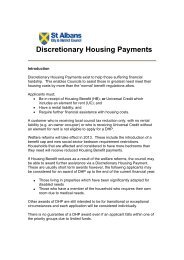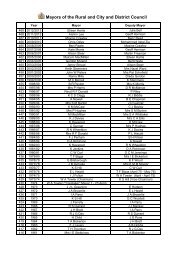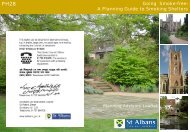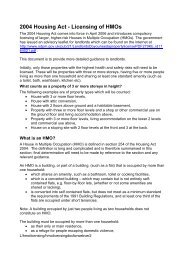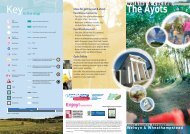Planning and renewable energy - St Albans City & District Council
Planning and renewable energy - St Albans City & District Council
Planning and renewable energy - St Albans City & District Council
Create successful ePaper yourself
Turn your PDF publications into a flip-book with our unique Google optimized e-Paper software.
PLANNING AND RENEWABLE ENERGY<br />
1. Introduction<br />
The release of greenhouse gases into the atmosphere is now<br />
widely acknowledged to be a significant contributor to climate<br />
change. Carbon dioxide released by the combustion of fossil fuels<br />
for electricity generation, producing heat or as a fuel for transport is<br />
the major source of man-made greenhouse gases. There are two<br />
main ways of combating this, namely reducing <strong>energy</strong> dem<strong>and</strong><br />
through efficiency of use <strong>and</strong> using alternative low carbon or<br />
<strong>renewable</strong> <strong>energy</strong> supplies.<br />
The UK is committed to meeting a significant proportion of our<br />
<strong>energy</strong> needs from <strong>renewable</strong> <strong>energy</strong> sources. Government targets<br />
are to generate 10% of the nation’s electricity from <strong>renewable</strong>s by<br />
2010, 15% by 2015 <strong>and</strong> 20% by 2020. Nationally, in 2003 only 4%<br />
of our electricity was obtained from <strong>renewable</strong> sources.<br />
On a regional level, in 2001 the East of Engl<strong>and</strong> only produced<br />
0.45% of its dem<strong>and</strong> from <strong>renewable</strong> sources. All regions were<br />
asked by the Government to set targets for themselves up to 2010<br />
<strong>and</strong> the East of Engl<strong>and</strong> adopted the figure below, which was<br />
detailed in the Draft East of Engl<strong>and</strong> Regional Spatial <strong>St</strong>rategy<br />
(RSS), published in December 2004.<br />
To produce 14% of the region’s electricity from <strong>renewable</strong><br />
sources by 2010 (including offshore wind, 10% if offshore wind<br />
is excluded).<br />
This regional target was then dissected into county targets, <strong>and</strong><br />
153,000 Megawatt hours per year were proposed for<br />
Hertfordshire. This figure equates to only 3% of Hertfordshire’s<br />
predicted <strong>energy</strong> consumption in 2010.<br />
In an effort to find ways of meeting this target, Hertfordshire County<br />
<strong>Council</strong> <strong>and</strong> all 10 <strong>District</strong> <strong>Council</strong>s in the county commissioned<br />
specialist consultants to produce a report setting out what <strong>and</strong><br />
where the potential was in Hertfordshire for <strong>renewable</strong> <strong>energy</strong><br />
development.<br />
The conclusions of this report were that Hertfordshire did have the<br />
potential to meet its target, but only if new <strong>and</strong> existing development<br />
started to implement <strong>renewable</strong> <strong>energy</strong> technologies as soon as<br />
possible. One key barrier to this happening was identified as the<br />
lack of positive planning policies encouraging <strong>renewable</strong> <strong>energy</strong><br />
technologies.<br />
Government guidance in <strong>Planning</strong> Policy <strong>St</strong>atement (PPS) 22<br />
provides local authorities with the backing to encourage <strong>and</strong> require<br />
<strong>renewable</strong> <strong>energy</strong> technology in development through their Local<br />
Development Frameworks.<br />
In October 2006, the <strong>Council</strong>’s <strong>Planning</strong> Policy Advisory Panel<br />
agreed that a good practice planning guidance leaflet should be<br />
produced to initiate <strong>St</strong> <strong>Albans</strong> <strong>City</strong> <strong>and</strong> <strong>District</strong> <strong>Council</strong>’s contribution<br />
to the county target, whilst also protecting our historic built<br />
environment. It was also considered necessary to provide planning<br />
guidance to homeowners wishing to install small-scale domestic<br />
schemes, which are becoming more popular <strong>and</strong> widely available.<br />
2. What is <strong>renewable</strong> <strong>energy</strong>?<br />
The definition of <strong>renewable</strong> <strong>energy</strong> covers those <strong>energy</strong> flows that<br />
occur naturally <strong>and</strong> repeatedly in the environment. These are the<br />
wind, the fall of water, the movement of the oceans, <strong>energy</strong> from<br />
the sun <strong>and</strong> also from biomass (the burning of crops to generate<br />
various fuel types). Below is a brief guide to the types of <strong>renewable</strong><br />
<strong>energy</strong> that may be suitable for <strong>St</strong> <strong>Albans</strong> <strong>District</strong>.<br />
Wind<br />
The United Kingdom is the windiest part of Europe <strong>and</strong> there are<br />
currently 1,400 operational wind turbines providing electricity for<br />
over 700,000 homes, therefore reducing carbon dioxide emissions<br />
by three million tonnes per year. Whilst there is little potential within<br />
<strong>St</strong> <strong>Albans</strong> <strong>District</strong> for large scale wind turbines, there is a significant<br />
opportunity for small-scale domestic turbines to be integrated into<br />
both existing <strong>and</strong> new build development.<br />
1<br />
2



